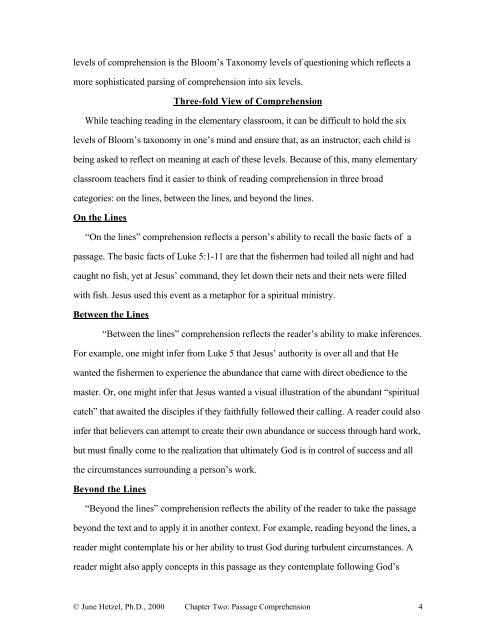Reading in the Elementary Classroom Chapter Two: Passage ...
Reading in the Elementary Classroom Chapter Two: Passage ...
Reading in the Elementary Classroom Chapter Two: Passage ...
Create successful ePaper yourself
Turn your PDF publications into a flip-book with our unique Google optimized e-Paper software.
levels of comprehension is <strong>the</strong> Bloom’s Taxonomy levels of question<strong>in</strong>g which reflects a<br />
more sophisticated pars<strong>in</strong>g of comprehension <strong>in</strong>to six levels.<br />
Three-fold View of Comprehension<br />
While teach<strong>in</strong>g read<strong>in</strong>g <strong>in</strong> <strong>the</strong> elementary classroom, it can be difficult to hold <strong>the</strong> six<br />
levels of Bloom’s taxonomy <strong>in</strong> one’s m<strong>in</strong>d and ensure that, as an <strong>in</strong>structor, each child is<br />
be<strong>in</strong>g asked to reflect on mean<strong>in</strong>g at each of <strong>the</strong>se levels. Because of this, many elementary<br />
classroom teachers f<strong>in</strong>d it easier to th<strong>in</strong>k of read<strong>in</strong>g comprehension <strong>in</strong> three broad<br />
categories: on <strong>the</strong> l<strong>in</strong>es, between <strong>the</strong> l<strong>in</strong>es, and beyond <strong>the</strong> l<strong>in</strong>es.<br />
On <strong>the</strong> L<strong>in</strong>es<br />
“On <strong>the</strong> l<strong>in</strong>es” comprehension reflects a person’s ability to recall <strong>the</strong> basic facts of a<br />
passage. The basic facts of Luke 5:1-11 are that <strong>the</strong> fishermen had toiled all night and had<br />
caught no fish, yet at Jesus’ command, <strong>the</strong>y let down <strong>the</strong>ir nets and <strong>the</strong>ir nets were filled<br />
with fish. Jesus used this event as a metaphor for a spiritual m<strong>in</strong>istry.<br />
Between <strong>the</strong> L<strong>in</strong>es<br />
“Between <strong>the</strong> l<strong>in</strong>es” comprehension reflects <strong>the</strong> reader’s ability to make <strong>in</strong>ferences.<br />
For example, one might <strong>in</strong>fer from Luke 5 that Jesus’ authority is over all and that He<br />
wanted <strong>the</strong> fishermen to experience <strong>the</strong> abundance that came with direct obedience to <strong>the</strong><br />
master. Or, one might <strong>in</strong>fer that Jesus wanted a visual illustration of <strong>the</strong> abundant “spiritual<br />
catch” that awaited <strong>the</strong> disciples if <strong>the</strong>y faithfully followed <strong>the</strong>ir call<strong>in</strong>g. A reader could also<br />
<strong>in</strong>fer that believers can attempt to create <strong>the</strong>ir own abundance or success through hard work,<br />
but must f<strong>in</strong>ally come to <strong>the</strong> realization that ultimately God is <strong>in</strong> control of success and all<br />
<strong>the</strong> circumstances surround<strong>in</strong>g a person’s work.<br />
Beyond <strong>the</strong> L<strong>in</strong>es<br />
“Beyond <strong>the</strong> l<strong>in</strong>es” comprehension reflects <strong>the</strong> ability of <strong>the</strong> reader to take <strong>the</strong> passage<br />
beyond <strong>the</strong> text and to apply it <strong>in</strong> ano<strong>the</strong>r context. For example, read<strong>in</strong>g beyond <strong>the</strong> l<strong>in</strong>es, a<br />
reader might contemplate his or her ability to trust God dur<strong>in</strong>g turbulent circumstances. A<br />
reader might also apply concepts <strong>in</strong> this passage as <strong>the</strong>y contemplate follow<strong>in</strong>g God’s<br />
© June Hetzel, Ph.D., 2000 <strong>Chapter</strong> <strong>Two</strong>: <strong>Passage</strong> Comprehension 4


